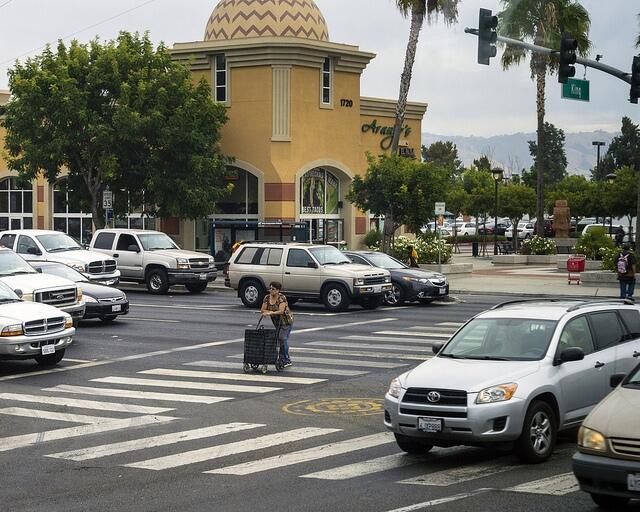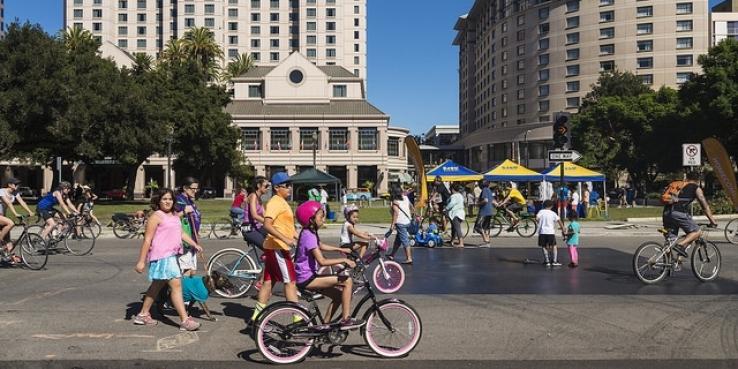From Copenhagen to Los Angeles, cities are finding new ways to address their interconnected health, climate, congestion, equity and economic challenges through innovative thinking about public spaces. As the featured guest of November’s San Jose Public Life Summit, urbanist and public design advocate Gil Peñalosa challenged leaders and residents in San Jose to move forward with ambitious projects that support sustainable mobility, vibrant public spaces and civic engagement. He proposed four guiding questions to the community:
1. Where does the community meet as equals?
Peñalosa pointed to several examples of community gathering places from across the globe to kick off the conversation. For example, Frederick Law Olmstead designed Manhattan’s Central Park with a clear goal: to build a place where all members of the New York City community could meet as equals and enjoy physical activity, as well as social integration. As a result, Central Park is both an iconic centerpiece for the city and an important part of the community fabric, knitting together communities that would otherwise have little interaction.
Today, Peñalosa explained, Olmstead’s vision is inspiring a new kind of community gathering in cities worldwide: Ciclovía, literally “bike path” in Spanish. This ground-breaking weekly event, started in Bogotá, Colombia, draws more than 1.5 million people around the world to walk, bike, skate and enjoy more than 70 miles of streets opened to people — and closed to automobile traffic. Founded in 1976, Ciclovía started small and grew in the ’90s under the mayorship of Gil’s brother, Enrique Peñalosa. (Gil, was Bogotá’s parks director at the time.) Thirty years later, the concept has spread everywhere from Tokyo, Japan to Kiev, Ukraine. San Jose adopted the concept with its annual Viva Calle event, started in 2015. Peñalosa challenged leaders to build on the success of Viva Calle and take the commitment to the next level by closing the streets to cars weekly.
2. Would you send an 8-year-old or an 80-year-old walking or bicycling to the neighborhood park?
If you would, Peñalosa said, then your neighborhood is safe enough. If you wouldn’t, then it’s not safe enough. This “8 80 Rule of Thumb” is an easy test that anyone can use to understand the safety and mobility options of the built environment. What if all parks, sidewalks, streets and public spaces had to be fantastic for an 8-year-old and an 80-year-old? The result would be city design that works well for residents of all ages, rather than for a smaller subset of the population — mainly those who are 30 years old and athletic. This includes adding color, imagination and interaction to parks, bus stops and gardens.
3. Who is the top priority in our public spaces?
High speed limits and public outcry at potholes send the message that cars are the top priority in cities. Meanwhile, poor sidewalk conditions and incomplete networks tell pedestrians that they are second-class users. This priority setting has dangerous results: In the last 10 years, 47,000 people were killed by drivers while walking in public space in the United States.
 Street design that prioritizes cars over pedestrians makes for unsafe crossings. Photo by Sergio Ruiz for SPUR.
Street design that prioritizes cars over pedestrians makes for unsafe crossings. Photo by Sergio Ruiz for SPUR.Walking is the only individual means of personal mobility for most people. In order to elevate its role in our cities, Peñalosa argued, we must shift our thinking, dignify walking and create sidewalks and spaces that prioritize users who are on foot or riding a bicycle. That includes lower speed limits for cars, good sidewalks, street trees, parks and a complete network of protected bike lanes. Beyond that, cities must include amenities such as street art, sidewalk cafes and more. When great cities choose to dedicate space to people, people use that space. Peñalosa emphasized the need for people in this century to stand up and say, “If there’s not enough space for everything on our streets, we’ll just build for transit, bikes and pedestrians.”
4. What is getting in the way of moving projects forward?
While technical or financial limitations can often create barriers to projects, Peñalosa encouraged leaders in San Jose to recognize inaction as a political problem above all else. A sense of urgency about the growing and interconnected health, climate, congestion, equity and economic challenges is foundational. These challenges are real, and they’re impact many residents right now. As a result, community members and leaders must seize the opportunity to work together to build mobility and public space in new ways.
